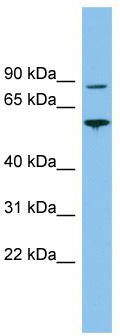VPS52 Rabbit Polyclonal Antibody
Frequently bought together (1)
Other products for "VPS52"
Specifications
| Product Data | |
| Applications | WB |
| Recommended Dilution | WB |
| Reactivities | Human |
| Host | Rabbit |
| Isotype | IgG |
| Clonality | Polyclonal |
| Immunogen | The immunogen for anti-VPS52 antibody: synthetic peptide directed towards the middle region of human VPS52. Synthetic peptide located within the following region: RYWEQVLALLWPRFELILEMNVQSVRSTDPQRLGGLDTRPHYITRRYAEF |
| Formulation | Liquid. Purified antibody supplied in 1x PBS buffer with 0.09% (w/v) sodium azide and 2% sucrose. Note that this product is shipped as lyophilized powder to China customers. |
| Purification | Affinity Purified |
| Conjugation | Unconjugated |
| Storage | Store at -20°C as received. |
| Stability | Stable for 12 months from date of receipt. |
| Predicted Protein Size | 82 kDa |
| Gene Name | VPS52, GARP complex subunit |
| Database Link | |
| Background | This gene encodes a protein that is similar to the yeast suppressor of actin mutations 2 gene. The yeast protein forms a subunit of the tetrameric Golgi-associated retrograde protein complex that is involved in vesicle trafficking from from both early and late endosomes, back to the trans-Golgi network. This gene is located on chromosome 6 in a head-to-head orientation with the gene encoding ribosomal protein S18. |
| Synonyms | ARE1; dJ1033B10.5; SAC2; SACM2L |
| Note | Immunogen Sequence Homology: Dog: 100%; Pig: 100%; Rat: 100%; Horse: 100%; Human: 100%; Mouse: 100%; Bovine: 100%; Rabbit: 100%; Guinea pig: 100%; Zebrafish: 86% |
| Reference Data | |
Documents
| Product Manuals |
| FAQs |
| SDS |
{0} Product Review(s)
0 Product Review(s)
Submit review
Be the first one to submit a review
Product Citations
*Delivery time may vary from web posted schedule. Occasional delays may occur due to unforeseen
complexities in the preparation of your product. International customers may expect an additional 1-2 weeks
in shipping.






























































































































































































































































 Germany
Germany
 Japan
Japan
 United Kingdom
United Kingdom
 China
China



